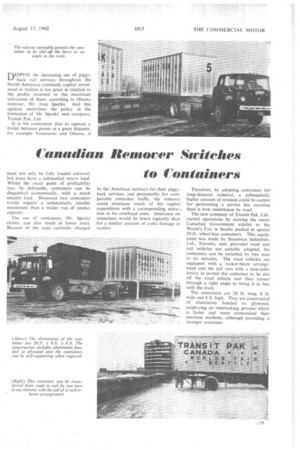Canadian ilemocer Switches
Page 59

If you've noticed an error in this article please click here to report it so we can fix it.
to Containers
DESPITE the increasing use of piggyback rail services throughout the North American continent, capital investment in trailers is too great in relation to the profits returned or the maximum utilization of them, according to Ottawa remover, Mr. Ivan Sparks. And this opinion underlines the policy in the formation of Mr. Sparks' new company, Transit Pak, Ltd.
It is his contention that to operate a trailer between points at a great distance, for example Vancouver and Ottawa, it
must not only be fully loaded outward. but must have a substantial return load. Whilst the exact point of profitability may be debatable, containers can be dispatched economically, with a much smaller load. Moreover two containers would require a substantially smaller investment than a trailer van of similar capacity.
The use of containers, Mr. Sparks claims, can also result in lower rates. Because of the rates currently charged by the American railways for their piggyback services, and presumably for comparable container traffic, the remover could eliminate much of his capital expenditure with a corresponding reduc-. tion in his overhead costs. Insurance on containers would be lower logically than for a similar amount of cubic footage in trailers. Therefore, by adopting containers for long-distance removal, a substantially higher amount of revenue could be earned for performing a service less exacting than is now undertaken by road.
The new company of Transit Pak, Ltd.. started operations by moving the entire Canadian Government exhibit to the World's Fair in Seattle packed in special 20-ft. wheel-less containers. This equipment was made by Steadman Industries, Ltd., Toronto, and, provided road and rail vehicles are suitably adapted, the containers can be switched by two men in six minutes. The road vehicles are equipped with a rocker-beam arrangement and the rail cars with a turn-table device to permit the container to be slid off the road vehicle and then turned through a right angle to bring it in line with the train.
The containers are 20 ft. long, 8 ft. wide and 8 ft. high. They are constructed of aluminium bonded to plywood, employing an interlocking process which is faster and more economical than previous methods, although providing a stronger container. .












































































































